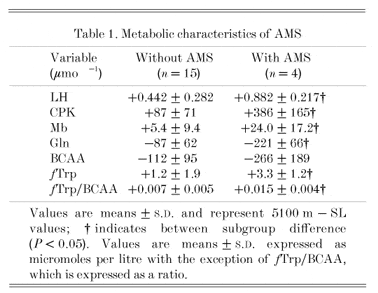Infections are common at high altitude and the associated physical symptoms can often be confused with acute mountain sickness (AMS). Since glutamine demand increases during the infective phase and supply may also be affected by free radical-mediated skeletal muscle damage which is especially prevalent amongst AMS susceptibles (Bailey et al. 2001), we hypothesised that peripheral glutamine metabolism would be compromised in subjects who developed altitude illness.
Therefore, nineteen male mountaineers volunteered for the present study which had been approved by the local ethics committee. Resting venous samples were obtained at sea level before (SL) and on the first morning after arrival at 5100 m following a 20 ± 5 day (mean ± S.D.) ascent trek. Samples were assayed for total creatine phosphokinase (CPK), myoglobin (Mb), lipid hydroperoxides (LH), glutamine (Gln), branched chain amino acids (BCAA) and free tryptophan (f Trp)]. Physical symptoms attributable to infectious illness were assessed on each of the 7 days before blood sampling at 5100 m. Clinical AMS on arrival at 5100 m was defined according to the Lake Louise diagnostic criteria as previously described (Hackett & Oelz, 1993).
Infection increased markedly at 5100 m (n = 10 vs. n = 0 at SL) and resulted in comparatively higher AMS scores (3.2 ± 2.7 (infected) vs. 1.3 ± 1.2 (healthy) points, P < 0.05, Mann-Whitney U test). Four subjects who contracted diarrhoea and pyrexia subsequently developed AMS and experienced a greater decrease in Gln and greater increase in LH, CPK, Mb, f Trp and ratio of f Trp/BCAA at 5100 m (Table 1). Pearson product moment correlations indicated that the decrease in Gln was associated with the increase in LH (r = -0.69, P < 0.05) and Mb (r = -0.73, P < 0.05) at 5100 m.
These data suggest that free radical-mediated damage to the systemic vasculature may impair its ability to synthesise and release glutamine, thus altering susceptibility to opportunistic infections and subsequent AMS. The prophylactic benefits of antioxidant supplementation (Bailey & Davies, 2001) suggest that the proposed mechanism may prove the cause rather than the consequence of illness.

